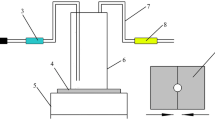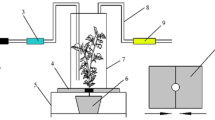Abstract
In this paper, we evaluate the use of an electronic nose (EN) containing 13 conducting polymer gas sensors to discriminate between patterns of volatile organic compounds (VOCs) emitted by plants. The VOC patterns examined were produced by tomato, cucumber and pepper plants under both healthy and infected or infested conditions. Leaves from the plants were subjected to mechanical damage or pest and disease attacks (i.e. spider mites infested or mildew infected) and others were judged against undamaged healthy leaves. Support vector machines (SVMs) with linear, polynomial and Gaussian radial basis function (RBF) kernels were used to process and classify the raw data collected. The SVM illustrated an ability to discriminate between different VOC patterns and hence was able to classify correctly the infected leaves using the EN data. The results indicate that the array of 13 EN gas sensors can discriminate among VOC patterns from undamaged and artificially damaged leaves of the three plant species. This study demonstrates the potential application of such an EN technology coupled with suitable pattern recognition and signal processing methods to be used as a real time pest and disease detection system in the greenhouse environment.
Similar content being viewed by others
References
Ampuero S & Bosset JO, 2003. The electronic nose applied to dairy products: a review. Sensor Actuat B-Chem 94, 1–12.
Arimura G, Kost C & Boland W, 2005. Herbivore-induced, indirect plant defense. Biochim Biophys Acta 1734, 91–111.
Baratto C, Faglia G, Pardo M, Vezzoli M, Boarino L, Maffei M, Bossi S & Sberveglieri G, 2005. Monitoring plants health in greenhouse for space missions. Sensor Actuat B-Chem 108, 278–284.
Borah S, Hines EL, Leeson MS, Iliescu DD, Bhuyan M & Gardner JW, 2008. Neural network based electronic nose for classification of tea aroma. Sens Instrum Food Qual Saf 2, 7–14.
Brudzewski K, Osowski S, Markiewicz T & Ulaczyk J, 2006. Classification of gasoline with supplement of bio-products by means of an electronic nose and SVM neural network. Sensor Actuat B-Chem 113, 135–141.
Capelli L, Sironi S, Céntola P, Del Rosso R & Il Grande M, 2008. Electronic noses for the continuous monitoring of odours from a wastewater treatment plant at specific receptors: Focus on training methods. Sensor Actuat B-Chem 131, 53–62.
Chen Q, Zhao J, Chen Z, Lin H & Zhao D, 2011. Discrimination of green tea quality using the electronic nose technique and the human panel test, comparison of linear and nonlinear classification tools. Sensor Actuat B-Chem 159, 294–300.
Çomak E & Arslan A, 2008. A new training method for support vector machines: Clustering k-NN support vector machines. Expert Syst Appl 35, 564–568.
Distante C, Ancon N & Siciliano P, 2003. Support vector machines for olfactory signals recognition. Sensor Actuat B-Chem 88, 30–39.
Du CJ & Sun DW, 2005. Pizza sauce spread classification using colour vision and support vector machines. J Food Eng 66, 137–145.
Dutta R, Morgan D, Baker N, Gardner JW & Hines EL, 2005. Identification of Staphylococcus aureus infections in hospital environment: electronic nose based approach. Sensor Actuat B-Chem 109, 355–362.
Farag MA, Ryu C, Sumner LW & Paré PW, 2006. GC-MS SPME profiling of rhizobacterial volatiles reveals prospective inducers of growth promotion and induced systemic resistance in plants. Phytochemistry 67, 2262–2268.
Gardner JW, Hines EL & Tang HC, 1992. Detection of vapours and odours from a multisensor array using pattern-recognition techniques. Part 2. Artificial neural networks. Sensor Actuat B-Chem 9, 9–15.
Heijden van der F, Duin R & Ridder D, 2004. Classification, Parameter Estimation, and State Estimation Engineering Approach Using MATLAB. Sussex: John Wiley & Sons Ltd.
Hewitt CN, MacKenzie A, Di Carlo P, Di Marco C, Dorsey J, Evans M, Fowler, D, Gallagher M, Hopkins J, Jones C, Langford B, Lee J, Lewis AC, Lim S, McQuaid J, Misztal P, Moller S, Monks PS, Nemitz E, Oram D, Owen S, Phillips G, Pugh T, Pyle JA, Reeves C, Ryder J, Siong J, Skiba U & Stewart D, 2009. Nitrogen management is essential to prevent tropical oil palm plantations from causing ground level ozone pollution. Proc Natl Acad Sci 106, 18447–18451.
Hines EL, Gardner JW & Potter C, 1997. Olfactory feature maps from an electronic nose. Meas Control 30, 262–268.
Jansen RMC, Hofstee JW, Wildt J, Verstappen FWA, Bouwmeester HJ & Henten EJV, 2009. Induced plant volatiles allow sensitive monitoring of plant health status in greenhouses. Plant Signal Behav 4, 824–829.
Kalman E, Löfvendahl A, Winquista F & Lundström I, 2000. Classification of complex gas mixtures from automotive leather using an electronic nose. Anal Chim Acta 403, 31–38.
Li H, Liang Y & Xu Q, 2009. Support vector machines and its applications in chemistry. Chemometr Intell Lab 95, 188–198.
Laothawornkitkul J, Taylor JE, Paul ND & Hewitt CN, 2009. Biogenic volatile organic compounds in the Earth system: a Tansley Review. New Phytol 183, 27–51.
Laothawornkitkul J, Moore JP, Taylor JE, Possell M, Gibson TD, Hewitt CN & Paul ND, 2008. Monitoring, discrimination of plant volatile signatures by an electronic nose: A potential technology for plant pest and disease. Environ Sci Technol 42, 8433–8439.
Luan F, Liu HT, Ma WP & Fan BT, 2008. Classification of estrogen receptor-β ligands on the basis of their binding affinities using support vector machine and linear discriminant analysis. Eur J Med Chem 43, 43–52.
Owen SM, Harley P, Guenther A & Hewitt CN, 2002. Light dependency of VOC emissions from selected Mediterranean plant species. Atmos Environ 36, 3147–3159.
Peris M & Escuder-Gilabert L, 2009. A 21st century technique for food control: electronic noses. Anal Chim Acta 638, 1–15.
Persaud K & Dodd G, 1982. Analysis of discrimination mechanisms in the mammalian olfactory system using a model nose. Nature 299, 352–355.
Sanchez VD, 2003. Advanced support vector machines and kernel methods. Neurocomputing 55, 5–20.
Sankaran S, Mishra A, Ehsani R & Davis C, 2010. A review of advanced techniques for detecting plant diseases. Comput Electron Agr 72, 1–13.
Sobanski T, Szczurek A, Nitsch K, Licznerski BW & Radwan W, 2006. Electronic nose applied to automotive fuel qualification. Sensor Actuat B-Chem 116, 207–212.
Sohn J, Hudson N, Gallagher E, Dunlop M, Zeller L & Atzeni M, 2008. Implementation of an electronic nose for continuous odour monitoring in a poultry shed. Sensor Actuat B-Chem 133, 60–69.
Tran Q, Li X & Duan H, 2005. Efficient performance estimate for one-class support vector machine. Pattern Recogn Lett 26, 1174–1182.
Vapnik VN, 1995. An overview of statistical learning theory. IEEE T Neural Networ 10, 988–999.
Vickers C, Possell M, Cojocariu C, Velikova VB, Laothawornkitkul J, Ryan A, Mullineaux P & Hewitt CN, 2009. Isoprene synthesis protects transgenic tobacco plants from oxidative stress. Plant Cell Environ 32, 520–531.
Zhang Z & Li G, 2007. A preliminary study of plant aroma profile characteristics by a combination sampling method coupled with GC-MS. Microchem J 86, 29–36.
Author information
Authors and Affiliations
Corresponding author
Rights and permissions
About this article
Cite this article
Ghaffari, R., Laothawornkitkul, J., Iliescu, D. et al. Plant pest and disease diagnosis using electronic nose and support vector machine approach. J Plant Dis Prot 119, 200–207 (2012). https://doi.org/10.1007/BF03356442
Received:
Accepted:
Published:
Issue Date:
DOI: https://doi.org/10.1007/BF03356442




